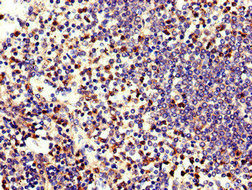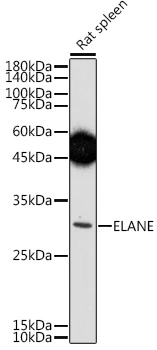Neutrophil elastase antibody [265-3K1]
GTX54464
ApplicationsFlow Cytometry, Western Blot, ELISA, ImmunoHistoChemistry, ImmunoHistoChemistry Paraffin
Product group Antibodies
TargetELANE
Overview
- SupplierGeneTex
- Product NameNeutrophil elastase antibody [265-3K1]
- Delivery Days Customer9
- Application Supplier Note*Optimal dilutions/concentrations should be determined by the researcher.Not tested in other applications.
- ApplicationsFlow Cytometry, Western Blot, ELISA, ImmunoHistoChemistry, ImmunoHistoChemistry Paraffin
- CertificationResearch Use Only
- ClonalityMonoclonal
- Clone ID265-3K1
- Concentration100 ug/ml
- ConjugateUnconjugated
- Gene ID1991
- Target nameELANE
- Target descriptionelastase, neutrophil expressed
- Target synonymsELA2, GE, HLE, HNE, NE, PMN-E, SCN1, neutrophil elastase, PMN elastase, bone marrow serine protease, elastase 2, neutrophil, elastase-2, granulocyte-derived elastase, leukocyte elastase, medullasin, polymorphonuclear elastase, polymorphonuclear leukocyte elastase
- HostMouse
- IsotypeIgG1
- Protein IDP08246
- Protein NameNeutrophil elastase
- Scientific DescriptionElastases form a subfamily of serine proteases that hydrolyze many proteins in addition to elastin. Humans have six elastase genes which encode structurally similar proteins. The encoded preproprotein is proteolytically processed to generate the active protease. Following activation, this protease hydrolyzes proteins within specialized neutrophil lysosomes, called azurophil granules, as well as proteins of the extracellular matrix. The enzyme may play a role in degenerative and inflammatory diseases through proteolysis of collagen-IV and elastin. This protein also degrades the outer membrane protein A (OmpA) of E. coli as well as the virulence factors of such bacteria as Shigella, Salmonella and Yersinia. Mutations in this gene are associated with cyclic neutropenia and severe congenital neutropenia (SCN). This gene is present in a gene cluster on chromosome 19. [provided by RefSeq, Jan 2016]
- Storage Instruction2°C to 8°C
- UNSPSC12352203




